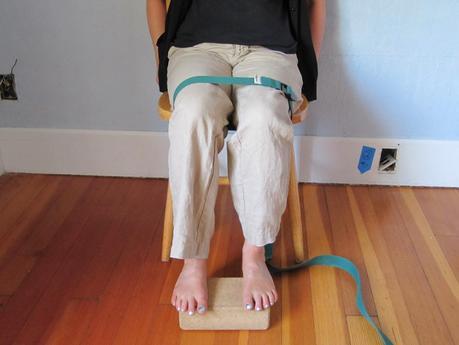 If you were to see me sitting at my desk right now as I write this you might think I look a bit strange. Because while I’m writing, I have a yoga strap wrapped around my thighs and my feet are resting on a yoga block. Why am I doing this?
If you were to see me sitting at my desk right now as I write this you might think I look a bit strange. Because while I’m writing, I have a yoga strap wrapped around my thighs and my feet are resting on a yoga block. Why am I doing this?Well, Baxter’s recent post on sitting (see Learning to Sit on the Floor, Part 2) talked about how to use props to sit help you sit comfortably on the floor, and that reminded me that for someone like me who spends many more hours a day sitting in a chair than on the floor, using yoga props at my desk can help me sit more comfortably in my chair! And lately my right hip and leg has been bothering me (I have mild arthritis in my right hip—see Goodbye, Lotus Pose), so I’ve been looking at what I can do both in my yoga practice and in my daily life to reduce my discomfort. And one thing I’ve been noticing is that I tend to sit with my legs crossed, even though I can feel it is hurting my hip—such a strong habit. So I realized that if I wrapped a strap around my legs, I’d be unable to cross my legs—yes, that feels better.
As it happens, using a strap like this can be helpful for most of us. Baxter recommended using a strap around the thighs in his post Friday Q&A: Sleeping on an Airplane to keep your legs symmetrical while you sleep. So if you sit at your desk with crossed legs and want to break yourself of the habit (hours of sitting in an asymmetrical position could be stressful to your body), try tying your legs together. Have it be loose enough so your knees are in line with your hip joints (not touching) but tight enough so the strap supports your thighs in place.
In his post about sleeping on an airplane, Baxter also recommended using a small pillow, folded blanket, or even a piece of rolled-up clothing for lumbar support. I’m sure many of you would find this helpful for maintaining the natural curves of your spine as you sit. Here are his instructions:
First, scoot your butt as far back into the seat as you can. Tip forward from your hips a bit, then place your lumbar support in the small of your back and lean back into it. Feel free to tinker with it so it feels just right for you.While I was noticing how my sitting position improved with the addition of the strap, I observed once again that because I’m on the short side, my feet don’t fully rest on the ground when I’m sitting on a chair, especially if I’m sitting with my butt against the back of the chair. So I decided to add the block under my feet—yes, that feels better, too.
I thought I’d share all this in case you’ve never thought about using props to improve your seated posture while you’re in a chair. People who are on the shorter side like me will often benefit from a footrest, either official or unofficial. People who are tall on the other hand will benefit from raising the seat of the chair so that as Shari mentioned in her post Learning to Sit on the Floor, Part 1 their knees are lower than their hips. Some people have adjustable office chairs, but if you don’t, you could add a firm folded blanket or a firm cushion to your chair seat to raise the seat up. This will make it easier for you maintain the natural curve of your lumbar spine—important for the health of your back—as you sit in your chair.
If you tend to slump and feel like going to extremes, you could even use a yoga strap to prevent your back from rounding.
Subscribe to YOGA FOR HEALTHY AGING by Email ° Follow Yoga for Healthy Aging on Facebook

